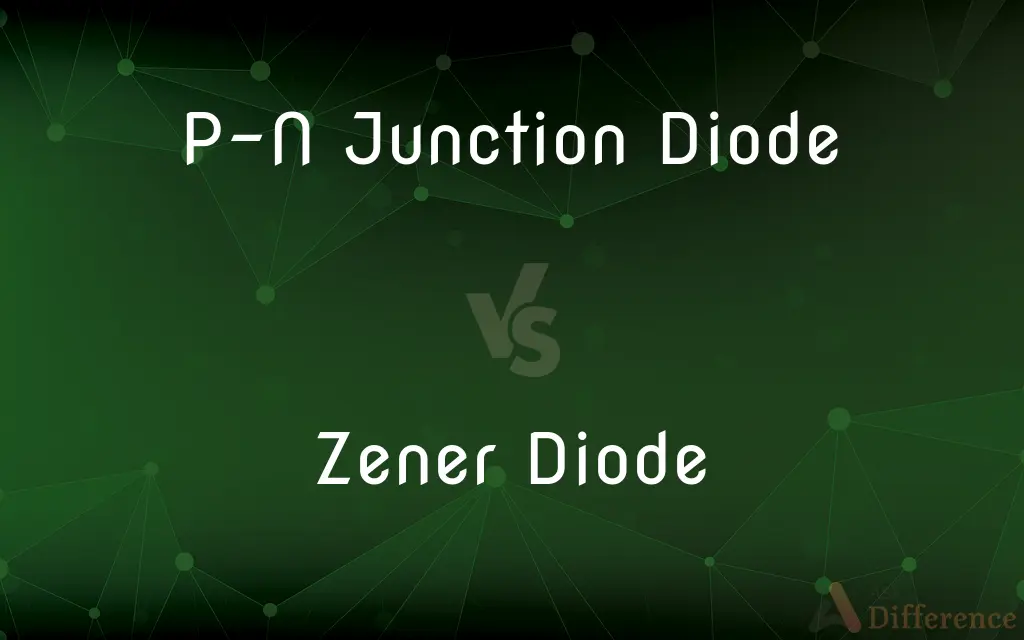P-N Junction Diode vs. Zener Diode — What's the Difference?
By Tayyaba Rehman — Published on December 12, 2023
A P-N Junction Diode is a basic semiconductor device allowing current flow in one direction, while a Zener Diode is a special diode designed to allow current in the reverse direction when a specific breakdown voltage is reached.

Difference Between P-N Junction Diode and Zener Diode
Table of Contents
ADVERTISEMENT
Key Differences
Fundamental Nature: A P-N Junction Diode is a fundamental semiconductor device formed when a p-type material is fused with an n-type material. This diode primarily allows current to flow in one direction, from the p-side to the n-side. On the other hand, a Zener Diode, while also a P-N junction, is specially designed to conduct in the reverse direction when a certain "Zener voltage" is achieved.
Primary Usage: The primary use of a P-N Junction Diode is rectification, turning alternating current (AC) into direct current (DC). In contrast, a Zener Diode is most commonly used in voltage regulation, ensuring a device receives a consistent voltage.
Operating Regions: A P-N Junction Diode typically operates in the forward bias condition where it conducts electricity, and in the reverse bias, it blocks electricity until breakdown. The Zener Diode, however, is intentionally operated in the reverse breakdown region to exploit its Zener voltage characteristic.
Breakdown Considerations: Exceeding a certain reverse voltage in a P-N Junction Diode can lead to its breakdown, which is usually an undesirable event. With a Zener Diode, the breakdown occurs at a predefined voltage (Zener voltage), and this phenomenon is harnessed for various applications.
Construction and Doping: While both diodes have a P-N junction, the Zener Diode often has a sharper P-N junction because of heavier doping, enabling its unique properties and making it distinct from regular P-N Junction Diodes.
ADVERTISEMENT
Comparison Chart
Fundamental Function
Allows current in one direction.
Conducts in reverse at a specific voltage.
Typical Application
Rectification.
Voltage regulation.
Operating Bias
Forward and reverse (avoiding breakdown).
Reverse (utilizing the breakdown region).
Breakdown Behavior
Undesirable event.
Harnessed for function.
Construction/Doping
Standard P-N junction.
Sharper junction due to heavier doping.
Compare with Definitions
P-N Junction Diode
Acts as an electrical check valve.
The P-N Junction Diode ensures that electricity flows the correct way in a circuit.
Zener Diode
A diode designed to conduct in reverse when a specific voltage is reached.
The Zener Diode stabilized the voltage in my circuit.
P-N Junction Diode
Blocks current in the reverse direction until a breakdown.
Ensure the P-N Junction Diode is properly biased to avoid damage.
Zener Diode
Has a predefined breakdown known as Zener voltage.
The 5.1V Zener Diode ensured consistent voltage delivery.
P-N Junction Diode
A semiconductor device formed from a p-type and n-type material junction.
The P-N Junction Diode is a fundamental component in rectifier circuits.
Zener Diode
Operates in the reverse breakdown region.
The unique behavior of the Zener Diode comes from its operation in the reverse bias.
P-N Junction Diode
Allows current to flow primarily in one direction.
Using a P-N Junction Diode, we can convert AC into DC.
Zener Diode
A heavily doped P-N junction diode with a sharp breakdown voltage.
Because of its specific doping, the Zener Diode behaves differently from a regular P-N Junction Diode.
P-N Junction Diode
Represents basic diode functionality in electronic circuits.
Almost every electronic device has a P-N Junction Diode inside.
Zener Diode
Primarily used for voltage regulation purposes.
By integrating a Zener Diode, the device remained safe from voltage spikes.
Common Curiosities
What's the main function of a P-N Junction Diode?
A P-N Junction Diode primarily allows current flow in one direction.
Why is the breakdown of a Zener Diode useful?
The breakdown of a Zener Diode is utilized to maintain a constant voltage across a circuit.
Is the P-N Junction Diode used in power supplies?
Yes, P-N Junction Diodes are fundamental components in rectifier circuits in power supplies.
Can a Zener Diode operate in forward bias?
Yes, but its primary function and uniqueness lie in its reverse bias operation.
Are P-N Junction Diodes used in digital circuits?
Yes, P-N Junction Diodes find applications in various digital circuits for tasks like logic operations.
At what voltage does a Zener Diode conduct in reverse?
A Zener Diode conducts in reverse at its specific Zener voltage.
Why is a Zener Diode unique?
A Zener Diode is designed to conduct current in reverse when a specific breakdown voltage is reached.
Can a P-N Junction Diode be used for voltage regulation?
While theoretically possible, Zener Diodes are better suited for voltage regulation tasks.
Is the P-N Junction in both diodes the same?
While both have a P-N junction, the Zener Diode's junction is heavily doped, creating a sharp breakdown voltage.
Can Zener Diodes handle high currents?
They are typically designed for low current operations; excessive current can lead to overheating and damage.
Can exceeding the Zener voltage damage the diode?
Yes, exceeding the Zener voltage beyond specified limits can damage the diode.
Why might one choose a Zener Diode over a regular diode?
For applications requiring voltage regulation, the Zener Diode's ability to maintain a constant voltage is invaluable.
How is the Zener voltage determined?
The Zener voltage is set during the manufacturing process, primarily through doping levels.
What happens if a P-N Junction Diode is reverse-biased?
It will block current until a breakdown voltage is reached, which can damage the diode.
Which diode should I use for voltage clamping?
Zener Diodes are ideal for voltage clamping due to their consistent breakdown voltage.
Share Your Discovery

Previous Comparison
New York Cheesecake vs. Chicago Cheesecake
Next Comparison
MDI vs. SDIAuthor Spotlight
Written by
Tayyaba RehmanTayyaba Rehman is a distinguished writer, currently serving as a primary contributor to askdifference.com. As a researcher in semantics and etymology, Tayyaba's passion for the complexity of languages and their distinctions has found a perfect home on the platform. Tayyaba delves into the intricacies of language, distinguishing between commonly confused words and phrases, thereby providing clarity for readers worldwide.












































